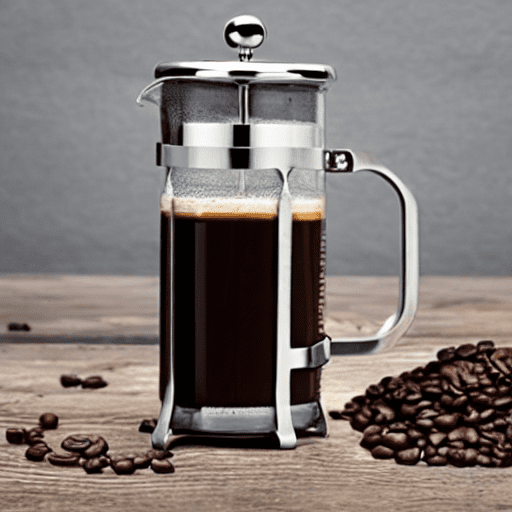One of the simplest coffee makers you can buy – but also one of the stars of the coffee world. Beloved by people the world over, a French press gives you complete control over the strength of brew you produce. Ironically in Europe, it’s called a cafetiere. Though it has also been known as a cafetière à piston, press pot, coffee plunger and coffee press. Using a French press can teach you the essentials of brewing coffee. It’s also a favorite of many coffee experts because it makes great coffee.
Pros and Cons of Choosing to use a French press
What is a French press/caffetiere?
It brews coffee by forcing hot water through ground coffee beans. Most are made of glass or plastic carafe with a plunger that fits tightly in the top. The plunger has a fine mesh filter attached, which traps the ground coffee beans as the hot water is forced through them.
How to use a French press:
Short answer:
You have experience using other coffee brewers like the AeroPress, and know how to adjust the ratio of coffee to water you enjoy best
Brew your coffee by adding coarsely ground coffee to the press, pouring over hot water, stirring, and then waiting around 4 minutes. After the coffees brewed, press the plunger down slowly trapping the coffee grounds at the bottom of the press. Serve and enjoy!
Top Tip 1: if you are used to brewing more finely ground coffee, like you would with an AeroPress, you will need a longer brew time (try 4-5 minutes) to fully extract the flavor.
Top Tip 2: It’s mighty important to get the right French press coffee ratio. You don’t want to drink over-strong coffee or something weak and flavorless.
Top Tip 3: Don’t forget you can even use a French press to make a shot of espresso. Take a quick look at How to make espresso with a french press.
Longer explanation:
You are a first time with a manual brewer, or looking to improve your technique.
The easiest way to check out how to use a cafetiere is via a recipe:
Choosing the perfect coffee beans
Making coffee with a cafetiere you should choose either a 100% arabica coffee or a high-quality blend of arabica and robusta coffees.
Arabica beans: known for their smooth flavor, gorgeous citrus and floral aromas and lack of bitterness, making them perfect for coffee. But because pressed coffee tends to lack acidity and be less bitter, you may find it lacking in ‘bite’. If so, go for a good blend of robusta and arabica coffee beans.
Using a blend of arabica and robusta beans will reward you with a cup that’s full of flavor and body. As an added bonus, there is more caffeine in robusta than arabica coffee, so you’ll get an energizing cup of coffee that’s perfect for those early mornings.
Types of French press
French press with glass carafe Highly Recommended
Whilst available in a range of sizes. I recommend starting with a standard (small 12oz / 0.35 liter) press as an obvious ‘toe-in-the-water’ starting point. It is big enough for you to enjoy a hearty mug, or two cups, of the resulting brew. But, it is small enough for you to try out different water-to-coffee ratios and brewing times. Once you find the perfect brew for you, a French press becomes a very easy-going companion to call upon for a quick and refreshing cup of joe.
Made from tempered glass, so less likely to break, a glass press is easy to clean and very long-lasting.
Stainless steel press Recommended
The stainless steel cafetiere shares many of the good qualities of a glass press. It doesn’t allow you to see what’s going on with the brewing process. That can be annoying when you are pushing down the plunger.
Go for a double walled one like a travel mug. This preserves the coffee temperature
Plastic press Not Recommended
A plastic press makes a more portable and less breakable travel solution. But as with all things plastic, remember to check if it’s recyclable. It will be more prone to scoring from the action of the plunger. Also, it’s not going to last as long as a glass French press.
Travel press Highly recommended
This is a hybrid between a French press and a travel mug. If that appeals to you for speed and simplicity then it’s a good combination.
Make sure that you buy a good quality travel French press because the last thing you want is a travel coffee that gets cold too quick or worse still spills coffee.
Large press Recommended
French presses are available in a range of sizes all the way up to 51oz (1.5liters). This makes it great for big families, and also for when you have guests. But don’t think that it’s a shortcut to use for making a day’s worth of fresh coffee. Left standing, not only will French press coffee get cold, it will become stale.
It’s far better to make your coffee in smaller batches. Use it as soon as it’s fully brewed to avoid it going stale. That’s a truth for all coffee drinks.
Electric press Recommended
Wow, I started by telling you the french press is one of the most simple and easy-to-use coffee makers. Now I am recommending an automated french press.
As the name implies, electric french press coffee makers take away the need to separately heat the water. Some even have built in stirrers, meaning you can speed up the brewing time. You can even use them to heat and froth milk for your cappucino or latte.
As an added bonus, an electric press can speed up the process of making iced coffee.

Equipment
- 1 French press coffee maker Prices can range from a few bucks upwards – see my top picks.
- 1 Coffee grinder optional
- 1 kitchen scale
- 1 food thermometer optional
- 1 kettle
- 1 mug (or 2 cups)
- 1 spoon
Ingredients
- 1.0 oz coffee beans / pre-ground coffee buy the best quality medium roast arabica coffee.
Notes
- Grind the beans to a coarse texture. ideally, the grounds will be about the same size as chunky sea salt. This ensures that the coffee grounds won’t escape through the mesh filter and mix with the coffee you pour into your cup. Top Tip: French press coffee is best when it’s fresh, so grind your beans just before brewing.
- If you’re new to French press coffee, start with light roast coffee beans. French press coffee is normally less acidic than with other brewing methods, so dark roasts can taste bitter. Experiment with different roasts and see what you like best.
- Remove the plunger from the press and half-fill with hot water to pre-heat the french press. Leave to stand for a few moments then discard the water. This ensures you will brew the coffee at the temperature you choose.
- Measure out the coffee grounds and pour them into the press. This is where it starts to get really interesting- because you need to get the ratio of coffee to water right if you are going to end up with a good (or even drinkable) cup of coffee. Top Tip: its best to use a scale, it will make the whole process much more accurate, AND you will find it easier to repeatedly get a cup of coffee just how you want it.
- As a starting point, I recommend you go with a regular coffee strength ratio of 1:15. So for every one measure (whether you are using spoons, or grams or scoops) of coffee grounds, you will need to add 15 measures of water. To help I have created a whole post on the french press coffee to water ratio.
- To bloom the coffee, pour a small amount of hot water over the coffee grounds. let it bubble and froth to release carbon dioxide (CO2) trapped in the coffee beans.
- Pour hot, but not boiling, water over the coffee grounds in the french press. If you have a thermometer (or even a temperature-controlled kettle) you will be able to get the perfect water temperature for you. Top Tip: Aim for a water temperature of between 180 – 190°F (roughly 80 – 90°C), NOT boiling because boiling water scalds the beans and leads to bitter flavorless coffee.
- Using the spoon, stir the coffee, I normally give it 20 slow stirs. then set the spoon aside and time the brew. Top Tip: course grounds release their flavor slowly, so give it 4-5 minutes.
- Once the coffee has brewed, insert the french press plunger and press down slowly. If you meet with great resistance, go a bit slower, or even give the process a few seconds rest.
- when the plunger has reached the bottom of the press (it won’t go all the way to the bottom but will rest on top of the grounds), you can pour the coffee into your cup or mug of choice.
Nutritional Disclaimer
All nutritional information is an estimate only, based on third-party calculations derived from an online nutritional calculator, Spoonacular API. The data provided is a courtesy and should not be considered a guarantee or fact. Each recipe and nutritional value will vary depending on the ingredients and brands you use, your measuring methods and portion sizes. For accurate results, we recommend that you calculate the nutritional information yourself, using a preferred nutritional calculator or advice from a nutritionist, based on your ingredients and individual processes.
Best recipes for French press
French press espresso
Using a French Press to make the perfect Mocha
French press iced coffee
Hi, I’m Eric Loftuss, co-founder of Bean Thirst with my wife Sophie.
My Coffee journey started young. I used to help my mom with the weekly shopping trip and we always called in to a coffee wholesaler and retail outlet in our town.
I really started to learn about coffee when, while in college, I worked in a local coffee shop and trained as a barista. Even though I went on to qualify and work as a lawyer, I still get a kick out of brewing a cup of Joe.
Sophie and I are so glad to be part of your coffee journey. Find out more about us

